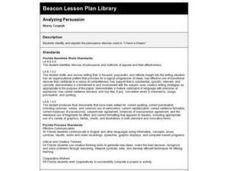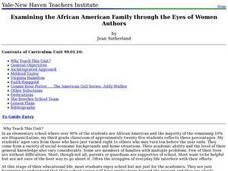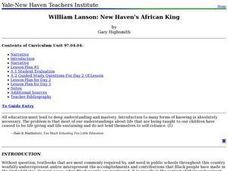Curated OER
The Chicano Movement in California - Culture, Causes, and Community
Students explore the culture and community of the Chicano movement in California using prints that emerged from the Chicano movement. The historical, binational, and bicultural components are examined in this three lessons unit.
Curated OER
Celebrating Martin Luther King Day
Students examine how Martin Luther King Day is celebrated in the United States. They practice treating others equally and respectfully. They also identify ways in which they can help King's dream of peace a reality.
Curated OER
Ballots, Bloomers and Boycotts
Students compare a controversial issue or policy in need of reform in their classroom to the suffrage movement of the 1800's. They research important figures in the suffrage movement, produce written pieces and complete worksheets.
Curated OER
The Battleground: Separate and Unequal Education
Students investigate the history of unequal education in the United States and the impact on African American history. For this unequal history lesson, students discuss the purpose of education and describe an ideal school. Students...
National Woman's History Museum
Inventive Women - Part 1
While a woman didn't invent the parasol, three women received patents for their improvements to the original design of umbrellas. In the first of a two-part series on inventive women, class members investigate the patent system to...
Curated OER
A Voice for the Times
Young scholars make connections with events of the Civil Rights Movement in the 1960's with songs made popular by Aretha Franklin.
Curated OER
"Separate But Equal" Revisited
Students examine the struggle for desegregation during the Civil Rights Movement. They assess ways in which race relations have and have not changed since the Brown v. Board of Education decision.
Curated OER
Turbulent Times of the Sixties
Students explore 1960's America. In this American history lesson, students read about and research 1960's political and entertainment figures, social activism, the Civil Rights Movement, and environmentalism as they complete writing and...
Curated OER
Breaking Barriers
Students examine the context of a speech delivered by Barack Obama. In this African-American history lesson, students discuss the 15th Amendment and the American Civil Rights Movement prior to analyzing Barack Obama's speech "A More...
Curated OER
Making Democracy Work for Everyone, 1877-1904
Students investigate the culture of the post Reconstruction South. They participate in a jigsaw research activity, conduct Internet research on an assigned topic, and write a report to present to the class.
Curated OER
Analyzing Persuasion
A reading of Dr. Martin Luther King Jr.'s "I Have a Dream" speech launches a study of rhetorical devices such as hyperbole, allusion, metaphor, simile, personification, connotative language and parallel structure. Class members then...
Curated OER
Arguments Against Ratifying the Constitution
Students define federalism, Federalist, and Anti-Federalist, debate issue of ratification in classroom convention, and take vote on whether to add bill of rights. Three lessons on one page.
Curated OER
Examining the African American Family through the Eyes of Women Authors
Students read stories by women authors on the characteristics of the African-American family. Using the internet, they research the history of issues that have affected African-American families from the Civil War to the Civil Rights...
Curated OER
Parenting in the Movies:Examining Responsibilities in Modern American Films
Young scholars use films to identify the characteristics of a good parent. In groups, they research the different types of parenting methods used during colonial times, the Civil War and the Civil Rights movement. As a class, they...
Curated OER
Injustice on our Plates
Students investigate boycott as a way to stand up and fight injustice. In this Teaching Tolerance instructional activity, students research consumer boycott movements and write about their impressions.
Curated OER
C¿¿sar Ch¿¿vez, Organizes the Farm Workers Association - Act I, Scene I "The House Meeting"
Eleventh graders analyze the development of federal civil and voting rights for minority groups. In groups, they discuss how Cesar Chavez organized the farm workers and the techniques he used when protesting. They define and practice...
Curated OER
CIVIL DISOBEDIENCE
Young scholars use events of the time to illustrate the significance of the 1965 Selma-to-Montgomery Voting Rights March.
Curated OER
Pay It Forward
Ninth graders practice serial reciprocity. In this "Pay It Forward," lesson, 9th graders watch the film of the same name and discuss how it mirrors work by Martin Luther King, Jr. Students then discuss service projects they can carry out...
National Endowment for the Humanities
A Raisin in the Sun: Whose "American Dream"?
How does Lorraine Hansberry's A Raisin in the Sun factor into a discussion of the American dream? High schoolers define the American dream and recognize the historical setting of the play. Additionally, they identify forms of...
Curated OER
Issues in Public Education During the Kentucky Civil Rights Era
Students conduct oral history interviews and research historical and contemporary media articles about multiculturalism and diversity.
Curated OER
Freedom Voices: Abolition and Suffrage in the United States
Learners explore abolition and suffrage in the United States.
Curated OER
William Lanson: New Haven's African King
Learners discuss the misrepresentations of African Americans in the United States. In groups, they examine the life and accomplishments of William Lanson and the importance of extending the Long Wharf. Together, they pretend they lived...
Library of Virginia
Antebellum Freedom
From indentured servitude to involuntary race-based servitude, slavery has taken many forms in American history. Class members examine three manumission petitions that reveal how the rights of African Americans and African American...
Curated OER
Examining Slave Auction Documents
Students compare the social and cultural characteristics of the North, the South, and the West during the antebellum period, including the lives of African Americans and social reform movements such as abolition and women’s rights.

























